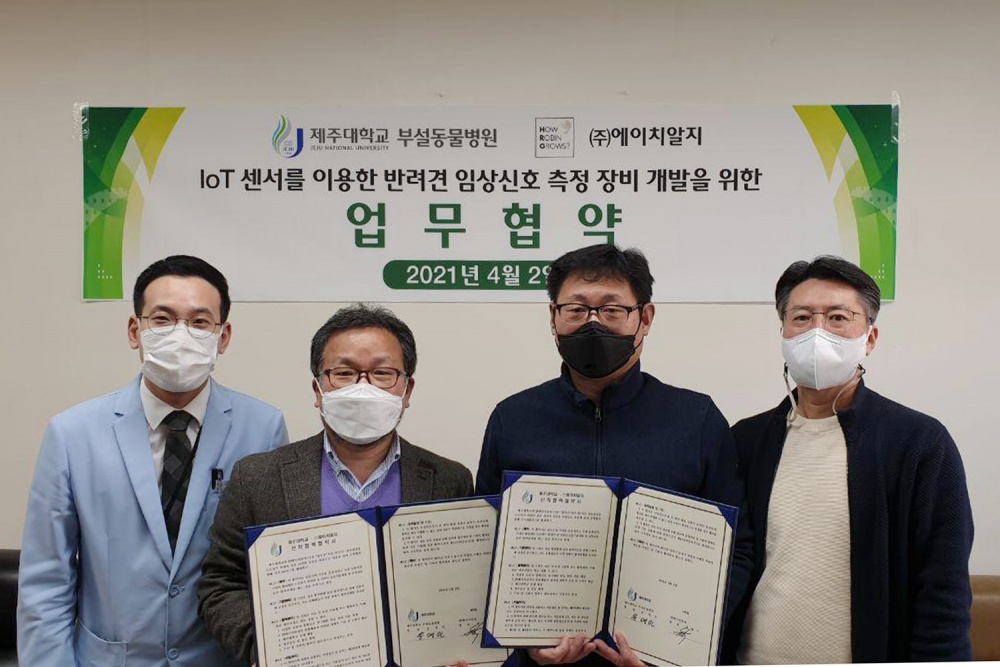JNU animal hospital to develop IoT-based clinical signal sensing gear for pets
· Writer : Jeju National University ·Date : 2021-04-19 00:00:00 ·View : 27
-
noImage
사물인터넷 이용 반려견 임상신호 측정장비 개발한다
JNU animal hospital to develop IoT-based clinical signal sensing gear for pets

부설동물병원-(주)에이치알지, 업무협약 체결
JNU Veterinary Teaching Hospital signs MOU with local wearable supplier HRG
Jeju National University Veterinary Teaching Hospital announced Wednesday (April 7) that the school signed a memorandum of understanding with HRG Co., Ltd. to develop an IoT device for biomedical signals sensed from pet dogs.
HRG is a local wireless communication system supplier specializing in measuring pet dogs’ biomedical signals. With the signing of the MOU, the company will now develop an apparatus to monitor the dog’s basic biomedical data (the body temperature, heart rate, breathing rate, etc.), which changes depending on the pet’s physical activities or health conditions. The monitoring results will allow for a continuous or temporary sensing of the symptoms of different dog diseases, such as diarrhea, vomiting, coughing, limping, or itching.
Specifically, the animal hospital and HRG expect to develop a wearable device which will obtain raw motion and audio data obtained from the pet’s digestive and musculoskeletal systems. A microelectromechanical systems mic and an inertial measurement unit will be used to save the data to the device’s secure digital (SD) card.
The university’s animal hospital explained that when the pet owner brings the monitoring results to the hospital, the vet ejects the SD card from the wearable gear and inserts it into the hospital computer’s card slot. Then, the software installed on the computer extracts six biomedical signals from the raw data representing the dog’s physical activities and medical symptoms. Subsequently, the biomedical signals are sent to the hospital’s Electronic Medical Records, where they are integrated with the pet’s previous static data, such as its medical history, breed, and age. Finally, a screening test detects the disease inferred from the data, using the artificial intelligence-based screening model for disease detection, whose development is in progress at the JNU Veterinary Teaching Hospital. The entire process is aimed at shortening the time required for treatment and achieving precision diagnosis.
To study the relationships between symptoms and diseases, the JNU Veterinary Teaching Hospital will gather the check-up data as well as the testing data provided through its veterinary diagnostic laboratory to add any confirmed cases to the system.
The hospital especially plans to sort out its patient groups by breed and size and verify the accuracy of their biomedical signals. The verification will be made for the dogs visiting the hospital, depending on the types of organs affected by diseases (the digestive system, respiratory system, cardiovascular system, musculoskeletal system, skin, etc.).
JNU Veterinary Teaching Hospital and HRG will distribute the wearable product through the network of South Korea’s veterinary clinics. Target customers of the wearable device include the owners of pet dogs aged 13 or over, and sales are expected to attain 10 billion won by 2023.
The domestic market size is predicted to be worth 5.4 billion won, while the overseas market size will likely surpass 800 billion won, including 540 billion won in the United States and 300 billion won in Japan.












 예비대학생
예비대학생 재학생
재학생 졸업생
졸업생 일반인
일반인 교직원
교직원